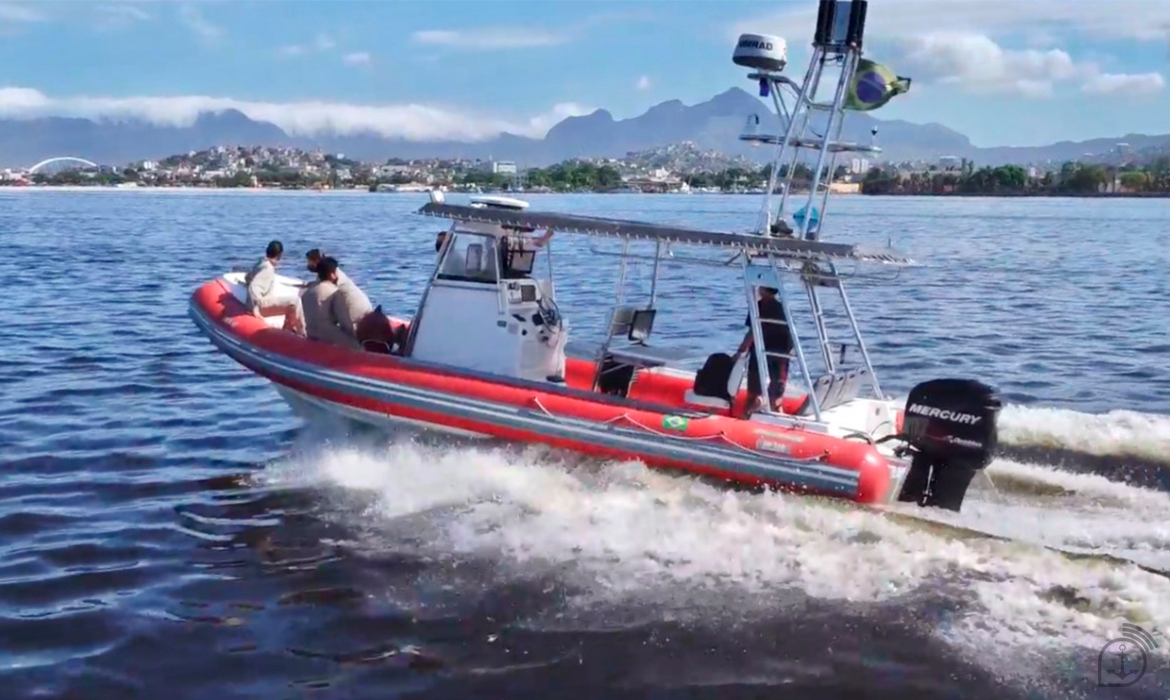Civil sectors, such as the offshore industry and universities, may also benefit from the project
By Captain-Lieutenant (RM2-T) Laís Dornelas de Araújo Itagyba – Rio de Janeiro, RJ
The Center for Naval Systems Analysis (CASNAV), of the Brazilian Navy (MB), develops several activities in the scientific-technological area. Among them is the VSNT-E Project (Veículo de Superfície Não Tripulado – Experimental – Unmanned Surface Vehicle – Experimental), which consists of increasing and monitoring inspections in the Blue Amazon, besides contributing to researches developed in the main universities in Brazil.
The technology of unmanned vehicles, whether aerial, surface, or underwater, is increasingly present in activities that involve risk, repetition, or adverse operating environments. This is not only true for defense activities, but also for civilian sectors such as the offshore industry, transportation and logistics of goods, location of objects on the seabed, and bathymetric surveys.
In this context, the MB carried out, in 2021, the conversion of the URCA-III speedboat into a VSNT-E (photo). The initiative took into consideration two main factors: the exponential and worldwide growth of the emergence of new Maritime Unmanned Systems (SMNT) and the availability of a modern research vessel, the URCA-III.
With the experimental surface vehicle, the Navy stimulates technological development in the segment of unmanned systems with a high cost-benefit ratio, as explained by the Officer in Charge at CASNAV’s Modeling and Simulation Division, Sea and War Captain Cláudio Coreixas de Moraes.
“Its main advantages are, firstly, not exposing the lives of operators to risks inherent to certain regions of operation, such as in minesweeping operations. Another advantage is to reduce the cost of the operation and the complexity of the related logistics. Finally, to expand the capacity of sensors for application in SisGAAZ (Blue Amazon Management System)”.
After the installation of a series of electronic systems, the ship is ready for remote operation. The technology has been presented to universities and several other Military Organizations that have already shown operational interest in the project, as highlighted by Sea and War Captain Coreixas. “As examples, the Directorate of Hydrography and Navigation will be able to conduct hydrographic surveys using unmanned vehicles, and the Fleet will be able to use the technology to conduct operational exercises. These are just a few examples of the potential of this new system.
Besides military use, there is interest from partner universities such as the Federal University of Rio de Janeiro (UFRJ), the Federal Fluminense University (UFF), and the University of São Paulo (USP). For UFF professor Esteban Walter Gonzalez Clua, the Navy’s participation, in automated and maritime vehicle projects, is of extreme importance. “First, the Navy knows, more than anyone else, all the navigability procedures, especially in a very busy region like Guanabara Bay. Second, the Navy has access to a huge amount of strategic information that is fundamental for navigation. And finally, the Navy brings with it a series of important demands, in which these vehicles can be used and applied, especially here at the university,” he said.
For the Executive Coordinator of UFRJ’s LabOceano, Paulo de Tarso Themistocles Esperança, the cooperation between Universities and Navy Research Centers is also a fundamental factor for the development of autonomous technology, especially in the area of Unmanned Vehicles, usually surrounded by strict confidentiality protocols. “There is a lot of research at the master’s and doctoral levels in the COPPE/UFRJ courses being developed by Brazilian Navy officers. Among these, I can specifically mention the PhD research that is in its final phase, which seeks to evaluate the influence of free surface effects on the maneuverability of submerged ships,” said the professor.
In this context, the Navy Technology Center in Rio de Janeiro opened the possibility that applied graduate research, managed by centers of excellence, can be conducted at the VSNT-E. With so many demands, VSNT-E has already been used this year in Fleet operations, such as “Aspirantex” and “Poseidon”, and is still being studied by CASNAV and the Navy Research Institute, and may soon be expanded.
Watch the video of the vehicle being tested in Guanabara Bay:
*** Translated by DEFCONPress Team ***
